
International Journal of General Studies (IJGS), Vol. 2, No. 2, July-September 2022, pp. 18-38 https://klamidas.com/ijgs-v2n2-2022-02/ |
||
|
An Assessment of the Multidimensional Pattern of Malaria Infection among Children under 0-5 Years in Anyigba, North-Central Nigeria By Edward Ukwubile Egwuaba & Adaeze Linda Olisa*
Abstract Malaria is estimated to kill more than 1 million people annually, the majority of whom are young children. The study assessed the incidents of malaria infection among children aged 0-5 years in Anyigba. This study was hinged on four specific objectives which include: determining the incidence and prevalence level of malaria among children aged 0-5 years in Anyigba, identifying the contributory factors of malaria infection among children of 0-5 in the area studied, identifying strategies employed to combat the incidence of malaria among children of 0-5 years, and ascertaining the economic toll of both preventive and curative measures of malaria. The paper adopted the health belief model to explain the social phenomenon reviewed. The study adopted the survey research design with simple random sampling techniques to reach and elicit responses from 278 selected study participants. Structured questionnaire was used as the primary instrument of data collection. Data were analyzed using the Statistical Package for Social Sciences (SPSS) software. Findings, among others, shows that the incidence and prevalence of malaria among children within age 0-5 years, were very high in the study area. Contributory factors responsible for malaria infection were parasites of genus plasmodium, low use of insecticide treated net, unsanitary environmental condition, poverty, poor behavioural attitude, and ignorance. The study among others recommends that the Nigerian government should release funds for malaria research and control activities; the increasing severity of the threat of malaria to the Nigerian residents, especially in Anyigba among children aged 0-5 years, and the diminishing ability to counter it, should be addressed by a more comprehensive and better integrated approach to malaria research and control; and for malaria control, short/long term interventions should be undertaken to ameliorate this holoendemic crisis of malaria infections. Keywords: assessment, children under 0-5, malaria, multidimensional pattern Introduction In sub-Saharan Africa, infectious diseases remain a serious public health threat (Marotta, Di Gennaro, Pizzol, Madeira, Monno, Saracino, Putoto, Casuccio, & Mazzucco, 2018). Malaria is one of the commonest infections, disproportionately affecting children and pregnant women. In 2019, an estimated 409, 000 people died of malaria, out of which 274, 000 were young children, and 94% of the infections and deaths occurred in Africa (Communicable Disease Control [CDC], 2019; World Health Organization, 2020). Although several plasmodium species are responsible for malaria, only a few of them cause most infections. Each year, there are an estimated 300-500 million clinical cases. Malaria is estimated to kill more than 1 million people annually, the majority of whom are young children. Ninety per cent of malaria cases in the world occur in Africa south of the Sahara. Children under 5 years of age are the worst affected by malaria. It is one of the leading causes of death among young children, (Akindele, 2017). Nigeria bears the world’s greatest malaria burden with approximately 51 million cases and 207, 000 deaths reported annually (approximately 30% of the total malaria burden in Africa), while 97% of the total population (approximately 173 million) is at risk of infection (World Health Organization, 2014). Moreover, malaria accounts for 60% of out-patients visits to hospitals and led to approximately 11% maternal mortality and 30% child mortality, especially among children less than 5 years (WHO, 2014; Nigeria Federal Ministry of Health National Malaria Control Programme, [NFMHNMCP], 2013). Malaria is caused by plasmodium falciparum, and the mosquitoes Anopheles gambiae, Anopheles funestus, Anopheles arabiensis, and Anopheles mouchetti are the major vectors that cause year-round transmission (WHO, 2015; Kar, Kumar, Singh, Carlton & Nandu, 2014). The devastating disease affects the country’s economic productivity, resulting in an estimated monetary loss of approximately 132 billion Naira (about 700 million USD) in treatment costs, prevention, and other indirect costs (Federal Ministry of Health, 2012; WHO, 2012). Children under five years are one of the most vulnerable groups affected by malaria, severe anemia, hypoglycemia and cerebral malaria are features of severe malaria more commonly seen in children than in adults (WHO, 2019). Children’s susceptibility to diarrhea, respiratory infections, and other illnesses increases when they develop repeated malaria infections (Greenwood, 2017). An estimated 2% of children who recover from cerebral malaria develop learning impairments and disabilities, including epilepsy and spasticity, resulting from the brain damage caused by the infection (Murphy & Breman, 2011). In general, malaria could cause severe outcomes in children in three major ways: First, since children do not usually have acquired immunity, they are more likely to develop severe malaria manifested by seizures or coma (cerebral malaria), which can cause emergency death. Second, they are also likely to develop it through complications related to repeated infections such as anemia. Finally, it causes low birth weight when it happens during pregnancy and increases the risk of death in the first mouth of life (WHO, 2018). Statement of the Problem The degree of prevalence of malaria in Anyingba is high. The WHO measures the degree of endemicity of malaria based on the spleen rate in children aged 2-9 years. Simon-Oke et al (2019) sums up WHO’s data as follows: Hypoendemic malaria occurs when spleen rate in children is less than 10%, Mesoendemic occurs when the spleen rate is 11-50% in children, Hyperendemic occurs when spleen rate is 75% in children and greater than 25% in adults while Holoendemic occurs when spleen rate is greater than 75% in children but very low in adults. They reported that “Malaria is holoendemic in Nigeria, with Plasmodium falciparum accounting for ninety five percent of all infections in the country”. The high prevalence rate of malaria in Anyigba town is attributed to the low use of ITN as only 75.6% of the population owned such nets (Ifatimehin et al., 2012; Musa et al., 2012; Edillo et al, 2008; and Shililu, Ghebremeskel, Seulu, Mengistu, Fekadu, Zerom & Beier, 2003). Malaria incidence rate in the population of the town remained very high with epidemics in 2012, reaching 467. 2 per 1000 person as against the global average of 23.6 per 1000 persons as reported by Castro et al. (2004). Therefore, Anyigba town is an endemic town as in every 1000 persons, 467 have had at least one episode of malaria infection within the year. As 403 new cases are reported annually, the transmission and distribution of the vector (female Anopheles mosquito) is greatly influenced by climatic factors as reported by Minakawa, Sonye, Mogi, Githeko, & Yan (2002) as well as the complex interplay of these factors on the sporozoites rates as posited by Kyes, Horrocks, & Newbold (2001) in their works. The high prevalence of malaria and its risk in Anyigba town is collectively dependent on the number of individuals suffering from the disease, climatic variables such as rainfall, maximum and minimum temperatures and humidity, low usage of ITN and environmental factors as supported by Ye-Ebiyo, Pollack, & Speilman, (2000), Munga, Minkawa, Zhou, Mushinzimana, & Barack (2006) and Krefis, Schwarz, Nkrumah, Acquah, Loag, Sarpong, & May (2010). Malaria incidence and prevalence is reported to be on the increase among children under 5 years despite all measures of intervention put forward in Anyigba town. There are over 1000 children at risk every year in Anyigba and indeed, it is estimated that about 50% of adult population in Anyigba experiences at least one episode yearly while children under the age five have up to 2-4 attacks of malaria annually (Afolabi, Onayede, Sule, & Olayide, 2012). Therefore, this study was carried out in order to provide baseline information on the increasing infection of malaria among under 5 years children and how it relates to the increasing prevalence and incidence of malaria among the teeming population of Anyigba town. Objectives of the Study The aim of this study was to assess the multidimensional pattern of malaria infection among children from 0-5 years in Anyigba community. Specifically, the objectives are:
Review of Related Literature Incidents of Malaria infection in Sub Saharan Africa including Nigeria is a major impediment to health, the disease has its greatest toll among under-five children and remains the single biggest cause of death among young children in Africa (World Health Organization/ UNICEF, 2003 cited in Ashikeni, Envuladu & Zoakah, 2013). Apart from this, the malaria endemic is so serious that every 30 seconds, an under-five year old child dies from malaria and many children who survive an episode of severe malaria suffer permanently from learning impairments or brain damage (World Health Organization, 2008 & UNICEF, 2004). It is also a major cause of anaemia in children and adults alike (Singh, Gupta, Acharya, Mahajan, & Verma, 2012 & Munthali, 2005). Malaria remains a huge public health problem in Sub-Saharan African countries and accounts for 10% of its disease burden even though it is both preventable and curable (World Health Report, 2014; Adetokunbo & Gilles, 2003). Studies on Incidence and Prevalence of Malaria across Nigeria Several researches have been done on the knowledge and prevalence of this disease in Sub-Saharan Africa. For instance in Nigeria Ashikeni, Envuladu & Zoakah (2013) studied the knowledge and prevalence of malaria amongst mothers in Kuje Area Council of the Federal Capital Territory, Abuja. Their study was a comparative community intervention study aimed at assessing the knowledge of malaria and practices related to its prevention and treatment among the women of Kuje Area Council. Using a sample of 232 mothers/ caregivers of under-five year old children, selected through a two staged sampling technique by balloting in Kuje and Rubochi community in Kuje Area Council of the Federal Capital Territory, their study found out that in entirety only 1.8% in the intervention group against the control group had good knowledge of the cause of malaria while 90.2% had fair knowledge which improved significantly after the intervention. Good knowledge of the preventive measures was also poor (5.4%) in the intervention group but increased significantly after 5 months of intervention. However, the control group showed no change. Their research then proved that Mothers of children under five in Kuje had poor knowledge of the cause of malaria and its prevention. Oregba, Onajole, Olayemi, & Mabadeje (2004) also carried out a study to compare the awareness of malaria and treatment knowledge of malaria amongst caregivers of young children in urban and rural areas of Ado-ode/Ota local government area in Ogun state. Oregba et al (2004) used a structured questionnaire administered to caregivers of children under the age of five years in 1472 households using a multistage random sampling design. The found out that many respondents (65%) in Ado-Ode attributed the cause of malaria to mosquitoes meaning that at least more than half has knowledge of malaria. Although caregivers in the urban area has more knowledge of malaria than rural area Prevalence of Malaria Disease Transmission of malaria disease is very high in Nigeria with an annual incidence of 31,913 per 100,000 populations; it is the leading cause of death in children aged under 5 years accounting for 20% of deaths among this group, closely followed by pneumonia and diarrhea diseases that accounted for 17 and 11% of deaths, respectively. Among adults, it is the second leading cause of death with a cause specific mortality rate of 131 deaths per 100,000 population compared to 132 deaths per 100,000 population from human immunodeficiency virus/acquired immune deficiency syndrome (HIV/AIDS) (World Health Organization (WHO), 2013). Available record ranks Sokoto State (the study area) among those with very high morbidity and mortality from malaria in Nigeria in 2006 (National Bureau of Statistics [NBS], 2016). In most countries of sub-Sahara Africa, malaria is transmitted through the bite of infected female anopheles mosquitoes. The disease is endemic and a leading cause of morbidity and mortality in the sub-region, although people develop a certain degree of immunity to it (FMoH, 2014) during the first decade of life (Brabin, 2010). Despite this, repeated exposure to mosquito bites causes pregnant women, especially primigravidae, to have a high susceptibility to Plasmodium falciparum infection, manifested by a high prevalence and intensity of parasitaemia (Steketee, 2015). Every year, at least 30 million pregnancies occur among women in malarious areas of Africa. Most of these women reside in areas of relatively stable malaria transmission. Nigeria is the most populous country in Africa, with an estimated population of over 168 million (World Bank, 2012). It therefore has the largest population of persons exposed to malaria infection in sub-Saharan Africa. In areas of Africa with stable malaria transmission, P. falciparum infection during pregnancy is estimated to cause as many as 10,000 maternal deaths each year, 8 to 14% of low birth weight babies, and 3 to 8% of all infant deaths (Guyat and Snow, 2011). Theoretical Thrust The Health Belief Model (HBM) was developed in the 1950s by Hochbaum, Rosenstock, kegels & Levental while working as social psychologists in the US public health services; they were inspired by a study on why people sought x-ray examination on tuberculosis (Green, 2008). These psychologists tried to understand why people would not accept disease preventive measures or early response to disease in terms of treatment (Rosenstock, 1974). Lately, the HBM has been adopted to explore a variety of health behaviours including access and utilisation of healthcare services (Boshamer & Bruce, 1999). HBM according to Rosenstock, Strecher & Becker (1974), has four major key variables which include: perceived sustainability, perceived severity, perceived benefits and perceived barriers. The model focuses on dimensions affecting an individual’s control over a specific action and uses those same dimensions to predict behaviour. According to Champion & Becker (1974), the basic components of the HBM are derived from a well-established body of psychological and behavioural theories whose models hypothesized that behaviours depend mainly upon two variables: the value placed by the individual on a particular goal and the individual’s estimate of the goal. When these variables are understood in health terms, the outcome is seen as:
The model is applied to this study based on the understanding that as care-givers will take health related action, such as in the context of the present study, the Health Belief Model provides reasonable explanation to the phenomenon of malaria prevalence, causes and prevention. By adopting the Health Belief Model, malaria is seen as a public health threat; the model also explains the belief that a specific health action will prevent or cure an illness. That is, individual’s course of action often depends on the person’s perceptions of the benefits and barriers related to health behaviour. In effect, poor usage of ITN in the society is a result of individual choice or undrstanding of the importance of early adoption of preventive measures and its relationship with appreciating the actual or potential severity and cues to action that could ameliorate the effect on the family’s finances. However, the Health Belief Model has been criticized on a number of grounds because it does not account for a person’s attitudes, beliefs, or other individual determinants that dictate a person’s acceptance of a health behavior. It does not take into account behaviors that are habitual (e.g., smoking) and thus may inform the decision-making process to accept a recommended action. It does not take into account behaviors that are performed for non-health related reasons such as social acceptability. The theory does not account for environmental or economic factors that may prohibit or promote the recommended action. It also assumes that everyone has access to equal amounts of information on the illness or disease. Furthermore the theory assumes that cues to action are widely prevalent in encouraging people to act and that “health” actions are the main goal in the decision-making process. Methodology Study Location/Population/Research Design This study used descriptive survey research design with both quantitative and qualitative techniques. The study population comprises of 275 caregivers, including male and females from the age of 18 years and above in Anyigba, Kogi State, Nigeria. As regards sample size and sampling technique, the study utilizes two-stage sampling techniques. The first stage involves the selection of some hospitals (ncluding Grimard Hospital, Christ the King Hospital, Kogi State University Teaching Hospital, Kogi State University School Clinic, and Zion Clinic and Maternity) in Anyigba district with each selected area allotted 55 samples bringing the total to 405. The second stage involves selection of sample of 55 respondents from each of the selected hospitals in the study area. The sample size of caregivers in the selected area is two hundred and seventy-five respondents (275), and they were all chosen as sample for the study using purposive sampling techniques. Data were collected by means of structured questionnaire and through journals and textbooks. The questionnaire contained both open and closed-ended questions. It was divided into two sections. Section A consists of questions on socio-demographic characteristics of the respondents regarding their gender, age (in years), marital status, educational level, and religious affiliation. Section B focuses on other substantive issues bothering on the study and they were all determined statistically using Cochran (1977) formula below: where n = sample size, z = z score determined for a specific confidence level as desired by the researcher is 95% confidence level and is 1.96 in z test table, q = the compliment of P (proportion) that is p-P = 50%, e = error margin or accuracy level of (0.05) %, p = proportion of occurrence or incidence which is used to measure how relatively varied a target population is. Data for this study was analyzed quantitatively using descriptive statistics and chi-square analysis, and it was entered into a statistical package for social sciences (SPSS) version 22 database. The quantitative analysis of data resulted from a well-structured close-ended and open-ended questions which involve the production and interpretation of tables, numeric values and frequencies that describe the data. Data Presentation/Analysis A total of two hundred and seventy-five (275) questionnaires were administered with two hundred and twenty-five (225), representing (82%), were duly filled and returned for analysis. The analysis carried out in this paper is in two sections. Section A focuses on the analysis of the respondents socio-demographic characteristics, while section B centered on the analysis of the objectives of the study.
The table above provides the socio-demographic characteristics of the study respondents. It can be deduced from the findings that majority (80%) of the respondents were females. This may be due to the fact that nursing job is often assigned to women in Nigeria. Also, the age of the respondents indicates that most (25.8%) of the respondents were within the age range of 26-33 years and had diploma educational qualification. Over 40% of the respondents were married and single while only few were divorced and separated. Regarding the educational qualification of respondents, the majority (45.3%) were diploma holders, 19.6% were B.Sc holders, 0.8% were M.Sc holders and 34.2% holds other certificates. Majority of the respondents (74.2%) were Christians while 25.8% were Moslems. Furthermore, the result reveals that the majority of the nurses (43.1) held nursing positions other than Nursing officer (26.7%), senior nursing officer (9.8%), principal; nursing officer (6.2%), assistant nursing officer (3.6%), chief nursing officer (1.8%). Data contained in the table shows that most (39.6%) had 1-5 years of working experience which is relatively good for this study, 30.7% had 6-10 years’ experience, and the least (8.4%) had not worked up to a year. Most of the respondents (45.7%) had a household size of four and more, 40.4% had 3-4 family household, and 13.8% of the respondents less than 3 family household. This shows that majority of study participants had children and must have encountered enough malaria incidents among their children to contribute meaningfully to the study Lastly, the monthly income data of the respondents showed that the majority (58.2%) earned between N20,000-N30,000.00, 28.4% earned between N30,000-N50,000, 10.2% earned between N50,000-N70,000 while 3.1% earned N70,000 and above.
Source: Field survey, 2022 The figure above shows that majority of the respondents (97%) agreed that the incidence of malaria is prevalent among children 0-5 years. This is in line with the view of Akindele (2017) who stated that globally the malaria situation is serious and getting worse. Each year, there are an estimated 300-500 million clinical cases of malaria. Malaria is estimated to kill more than 1 million people annually, the majority of whom are young children. Ninety per cent of malaria cases in the world occur in Africa south of the Sahara. Children under 5 years of age and pregnant women are the worst affected. It is one of the leading causes of death among young children (Akindele, 2017). Percentage Distribution showing respondents rating of incidence of Malaria among children 0-5 years
Distribution showing responses on Factors leading to Malaria Infection
The above indicates factors that might be responsible for malaria infection in Anyigba. According to the National Institute of Health (2015), malaria is caused by a single-celled parasite from the genus Plasmodium. More than 100 different species of Plasmodium exist. They produce malaria in many types of animals and birds as well as in humans. Four species of Plasmodium commonly infect humans. Each one has a distinctive appearance under the microscope, and each one produces a somewhat different pattern of symptoms. Two or more species can live in the same area and infect a single person at the same time. Plasmodium falciparum is responsible for most malaria deaths, especially in Africa (National Institutes of Health, 2015). Eighty nine percent of the respondents identified low use of insecticide treated net as a factor that leads to malaria. Insecticide treated bed nets (ITNs) were introduced in Nigeria as an effective means of preventing mosquito bites and malaria transmission following the meeting of African Heads of States in Abuja, Nigeria, in the year 2000 (RBM, 2010). Blood transfusion was not recognized as a major factor leading to malaria as 66% of the respondents disagreed with this. According to the National Health Institution (2010), a person with asymptomatic (no symptoms) P. malariae, however, can infect others, either through blood donation or mosquito bites. P. malariae has been wiped out from temperate climates but it persists in Africa. Plasmodium ovale is rare, can cause relapses, and generally occurs in West Africa. Other factors leading to malaria were unsanitary environmental condition (87%), poverty (91%), poor behavioural attitude (75%), ignorance (87%) and inadequate planned socio-economic project. Although all this can be identified as indirect factors, in one way or another they contribute to malaria infection in Anyigba.
The effect of malaria infection on children 0-5 years identified as shown in figure 3 were absenteeism (66%), days lost in schools (87%), lack of productivity due to brain damage (78%), loss of investment (83%), malnutrition (74%) and most often times result to death (94%).According to the United Against Malaria, citing Gallup (2001),the economic impact of malaria is estimated to cost Africa $12 billion every year; while Nigeria loses about N1 billion in economic value to the infection (Bukola, 2014). This figure factors in costs of health care, absenteeism, days lost in education, decreased productivity due to brain damage from cerebral malaria, and loss of investment and tourism. Furthermore, a 2011 Roll Back Malaria report found that in sub-Saharan Africa, 72% of companies reported a negative malaria impact, with 39% perceiving these impacts to be serious (WHO, 2009). Also findings by leading economists show that malaria causes an “economic growth penalty” of up to 1.3% per year in malaria endemic African countries, one of which is Nigeria (WHO, 2008).
Source: Field survey, 2022 From the figure above, the preventive methods identified were using a tropical repellent (81%), wearing clothes that cover most of the body (57%), and using a parathyroid containing flying insect spray in living and sleeping areas during evening and night time (88%), prompt and accurate diagnosis (67%), use of insecticides treated nets (78%), installing screens on all windows and doors (75%). In the absence of effective vaccine for malaria prevention and development of unacceptable levels of resistance to one drug after another by the malaria parasite, coupled with the development of resistance to insecticides by mosquitoes that transmit the disease; prevention of mosquitoes bite through the use of insecticide treated nets remains a very important strategy for malaria control (Lengeler & Snow, 2000; TerKuile et al., 2003).
In enhancing the economic toll of both preventive and curative measures of malaria on families figure 5 showed that giving health insurance to children (89%), distribution of free mosquito net (96%), reducing environmental pollutants (74%), complete monitoring of open water sources in households (61%), availability of anti-malarial drugs (80%), measurement of outcomes and impact (67%), awareness campaign on the vulnerability of children to malaria infection (89%), operational research has regards malaria (91%) and key interventions involved included, effective case management (68%). Discussion of Findings The incidence and prevalence of malaria among children within age 0-5 years was considered to be very high. This may be due to poor sanitation within Anyigba due to rising population. The rising population indicates the increasing pressure on the environment’s limited resource base. It also means that economic activities in the town are on the increase. These findings concur with the findings of Ifatimehin (2014) that poor sanitary conditions and poor environmental sanitation management were contributory elements to high prevalence of malaria infection in Anyigba. Consequently, investigating into the influencing factors of malaria infection among under 5 age children, findings from the study on contributory factors of malaria infection in Anyigba among others identified were parasites of genus plasmodium, low use of insecticide treated net, although blood transfusion was not recognized as a major factor leading to malaria but other factors identified leading to malaria were unsanitary environmental condition, poverty, poor behavioural attitude, ignorance and inadequate planned socio-economic project. This finding is in consonance with the findings of the National Institute of health (2015) that malaria is caused by a single-celled parasite from the genus Plasmodium. More than 100 different species of Plasmodium exist. They produce malaria in many types of animals and birds, as well as in humans. Four species of Plasmodium commonly infect humans. Each one has a distinctive appearance under the microscope, and each one produces a somewhat different pattern of symptoms. Two or more species can live in the same area and infect a single person at the same time. Plasmodium falciparum is responsible for most malaria deaths, especially in Africa (National Institutes of Health publication, 2015). Result of field survey shows that the preventive methods identified for combating malaria infections among 0-5 years children were using tropical repellent, wearing clothes that cover most of the body, using a parathyroid containing flying insect spray in living and sleeping areas during evening and night time, prompt and accurate diagnosis, use of insecticides treated nets and installing screens on all windows and doors. In the absence of effective vaccine for malaria prevention and development of unacceptable levels of resistance to one drug after another by the malaria parasite, coupled with the development of resistance to insecticides by mosquitoes that transmit the disease; prevention of mosquitoe bites through the use of insecticide treated nets remains a very important strategy for malaria control (Lengeler and Snow, 2000; TerKuile et al., 2003). On the economic toll of both preventive and curative measures of malaria on families in the study area, giving health insurance to children, distribution of free mosquito net, reducing environmental pollutants, complete monitoring of open water sources in households, availability of anti-malarial drugs, measurement of outcomes and impact, awareness campaign on the vulnerability of children to malaria infection, effective case management, operational research regarding malaria and resultant key interventions, were identified. Recommendations Based on the above findings of the study, the following recommendations were made:
Conclusion Malaria is indeed holoendemic and constitutes a global challenge to healthy living, particularly in sub-Saharan African countries. The causes of malaria infection among 0-5 year’s children in Anyigba as discovered from this study ranges from poor sanitary conditions, poor environmental management, poor diagnosis, difficulty in accessing medical facilities due to poverty, and inadequate ITNs. These make children within age 0-5 years in Anyigba vulnerable to malaria infection. Apart from health hazards, households afflicted by malaria suffer socio-economic losses. Proactive measures need to be taken to curtail this disease. References Afolabi, O. T., Onayede, A. A., Sule, S. S., & Olajide, F. O. (2012). Vectoral Control Synergy: Combined Use of ITN and Residual House Spray in Control of Malaria in South-Western Nigeria. J. Community Med Health Educ. 2: 161. Doi: 4172/2161. 1000161. Ashikeni, M.A, Envuladu, E.A, Zoakah, A.I. (2013). Malaria and the Use of the Insecticide-Treated Net (ITN) among Under-Five Children in Kuje Area Council of the Federal Capital Teritory Abuja, Nigeria. Journal of Mosquito Research; 3(6): 45-53. Castro, M. C., Yamaguta, Y., Mtasiwaa, D., Tanner, M., & Utzinger, J. (2004). Integrated Urban Malaria Control: A case Study in Dar es Salaam, Tanzania. Am. J. Trop Med Hyg, 71, 103-117. Communicable Disease Control (CDC). (2019). Malaria Impact of Malaria. https://www.cdc.gov/malaria/ malaria_worldwide /impact .html. Champion, V. & Skinner, C. S. (2008). The Health Belief Model. In: Glanz K, Rimer B, Viswanath K, editors. Health behaviour and health education. 4. San Francisco, CA: Jossey-Bass, 45–65. Edillo, F. E., Toure, Y. T., Lanzaro, G. C., Dolo, G., & Taylor, C. E. (2008). Spatial and Habitat Distribution of Anospheles gambiae and Anopheles arabiensis (Dipthera: Culicidae) in Banambani village, Mali. Journal of Medical Entomology, 40, 921-929. Greenwood, B. N. (2017). The Epidemiology of Malaria. Annals of Tropical Medicine & Parasitology, 2017: 91(7), 763-769. https://doi.org/10.1080/00034983.2017.11813201. Guyatt, H. L., & Snow, R. W. (2011). Malaria in pregnancy as an indirect cause of infant mortality in sub-Saharan Africa. Trans. R. Soc. Trop. Med.Hyg. 95:569–576. (3) (PDF) Impact of Malaria during Pregnancy on Low Birth Weight in Sub-Saharan Africa. https://www.researchgate.net/publication/8228172 _Impact_of_Malaria_during_Pregnancy _on_Low_Birth_Weight_in_Sub-Saharan_Africa. Accessed May 03 2022. Ifatemehin, O. O., Falola, O. O., & Odogbo, E. V. (2012). An Analysis of the spatial Distribution of Plasmodium sprozoite and Effects of Climate Correlates on Malaria infections in Anyigba Town, Nigeria. Global Journal of Health Science, Vol. 6, No. 1, 2014, pp. 115-126 Krefis, A. C., Schwarz, N. G., Nkrumah, B., Acquah, S., Loag, W., Sarpong, N., & May, J. (2010). Principal component analysis of socioeconomic factors and their association with malaria in children from the Ashanti Region, Ghana. Malaria Journal, 9, 201-208. http://dx.doi.org/10.1186/1475-2875-9-201 Kyes, S., Horrocks, P., & Newbold, C. (2001). Antigenic Variation at the Infected Red Cell surface in Malaria. Annual Review of Microbiology, 55, 673-707. http://dx.doi.org/10.1146/annurev.micro.55.1.673 Marotta, C. D., Di Gennaro, F., Pizzol, D., Madeira, C. G., Monno, L., Saracino, A., Putoto, G., Casuccio, A., & Mazzucco, W. (2018). The At-Risk Child Clinic (ARCC): 3 Years of Health Activities in Support of the Most Vulnerable Children in Beira, Mozambique. Int J Environ Res Public Health, 2018; 15(7):1350.https://doi:org/10.3390/ijerph1507.1350 PMID: 29954117 Minakawa, N., Sonye, G., Mogi, M., Githeko, A., & Yan, G. (2002). The effects of climatic factors on the distribution and abundance of malaria vectors in Kenya. J Med Entomol, 39(6), 833-841. Munga, S., Minkawa, N., Zhou, G., Mushinzimana, E., & Barack, O. O. (2006). Association between land cover and habitat productivity of malaria vectors in western Kenya highlands. American Journal of Tropical Medicine and Hygiene, 74, 69-75. Munthali, A. C. (2005). Managing Malaria in Under-Five Children in a Rural Malawian Village. Nordic Journal of African Studies 14(2): 127–146.64(1, 2 S): 57-67. Murphy, S. C. & Breman, J. G. (2011). Gaps in the Childhood Malaria Burden in Africa: Cerebral Malaria, Neurological Sequelae, Anemia, Respiratory Distress, Hypoglycemia, and Complications of Pregnancy. American Journal of Tropical Medicine and Hygiene. Musa, S. D., Ifatimehin, O. O., & Adeyemi, J. O. (2012). Climate variability and Malaria incidence in Lokoja, Kogi State. Journal of Geography, Environment and Planning, 8(2), 126-133. Oregba, I., Onajole, A. T., Olayemi, S. O., & Mabadeje, A. F. B. (2004). Knowledge of malaria amongst caregivers of young children in rural and urban communities in Southwest Nigeria. Tropical Journal of Pharmaceutical Research 3(1) DOI: 10.4314/tjpr.v3i1.14613 Rosenstock, I. M. Strecher, V. & Becker, J. (1988). Social learning theory and the healthbelief model. Health Education Quarterly, 15:175–183. DOI: 10.1177/109019818801500203. Shankar, A. H. (2010). Nutritional modulation of malaria morbidity and mortality. J. Infect. Dis 182: S37-S53. Shililu, J., Ghebremeskel, T., Seulu, F., Mengistu, S., Fekadu, H., Zerom, M.,& Beier, J. C. (2003). Larval habitat diversity and ecology of anophilene larvae in Eritrea. Journal of Medical Entomology, 40, 921-929. http://dx.doi.org/10.4269/ajmh.2009. 090156 Simon-Oke, I.A., Ogunseemi, M.F., Afolabi, O.J. and Awosolu, O.B. (2019). Prevalence of Malaria Parasites among Pregnant Women and Children under Five years in Ekiti State, Southwest Nigeria. Journal of Biomedicine and Translational Research, 5 (1) 2019, 5-11. Singh, D; Gupta, V; Acharya, S; Mahajan, S; & Verma, A. (2012). A case of Plasmodium vivax Malaria associated with severe autoimmune hemolytic anaemia. Annals of Tropical Medicine and Public Health; Accra Vol. 5, Iss. 2, (Mar 2012): 133-136. DOI:10.4103/1755-6783.95972 UNICEF (2010) Progress for children achieving the MDGs with equity. New York. United Nations (2015) The Millennium Development Goals Report. New York. United Nations Children’s Fund, World Health Organization, World Bank, United Nations Population Division (2015) Levels & Trends in Child Mortality. New York. World Health Organization (WHO). Fact Sheet Malaria. 30 November 2020. https://www.who.int/news-room /fact-sheets /detail /malaria. WHO. Malaria in Children Under-Five 2019. https://www.who.int/malaria/areas/high_risk_groups /children/en/. World Health Organization (WHO). World Malaria Report. 2016. https://www.who.int/malaria/publications/world -malaria-report-2016/report/en/. World Health Organization. The Multi-Country Evaluation of IMCI Effectiveness, Cost and Impact (MCE) -Progress Report’, May 2001-April 2002, WHO/FCH/CAH/02.16, Department of Child and Adolescent Health and Development, WHO, Geneva, 2002. Ye-Ebiyo, Y., Pollack, R. J., & Speilman, A. (2000). Enhanced development in nature of larval Anopheles arabiensis mosquitoes feeding on maize pollen. American Journal of Tropical Medicine and Hygiene, 61(1-2), 90-93. *About the Authors: Dr Edward Ukwubile Egwuaba (edwardegwuaba@yahoo.com) & Adaeze Linda Olisa (onyinyeolisah@yahoo.com) are of the Department of Sociology, Chukwuemeka Odumegwu Ojukwu University, Igbariam, Anambra State, Nigeria. |
||
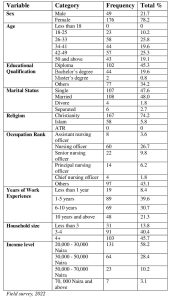
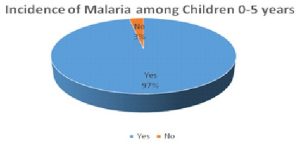
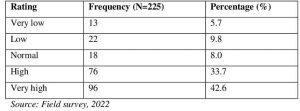 It can be deduced from table 4.2 that majority of the respondents considered incidence of malaria among children within age 0-5 years to be very high. This may be due to poor sanitation within Anyigba due to rising population. The rising population indicates the increasing pressure on the Environment’s limited resource base. It also means that economics activities in the town are on the increase. But most importantly contributes to poor environmental sanitation management.
It can be deduced from table 4.2 that majority of the respondents considered incidence of malaria among children within age 0-5 years to be very high. This may be due to poor sanitation within Anyigba due to rising population. The rising population indicates the increasing pressure on the Environment’s limited resource base. It also means that economics activities in the town are on the increase. But most importantly contributes to poor environmental sanitation management.
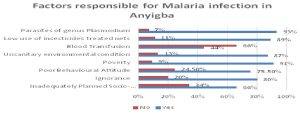
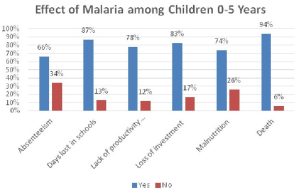

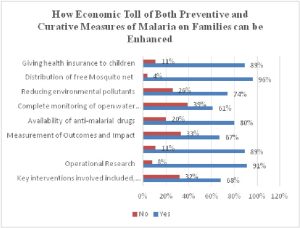 Source: Field survey, 2022
Source: Field survey, 2022